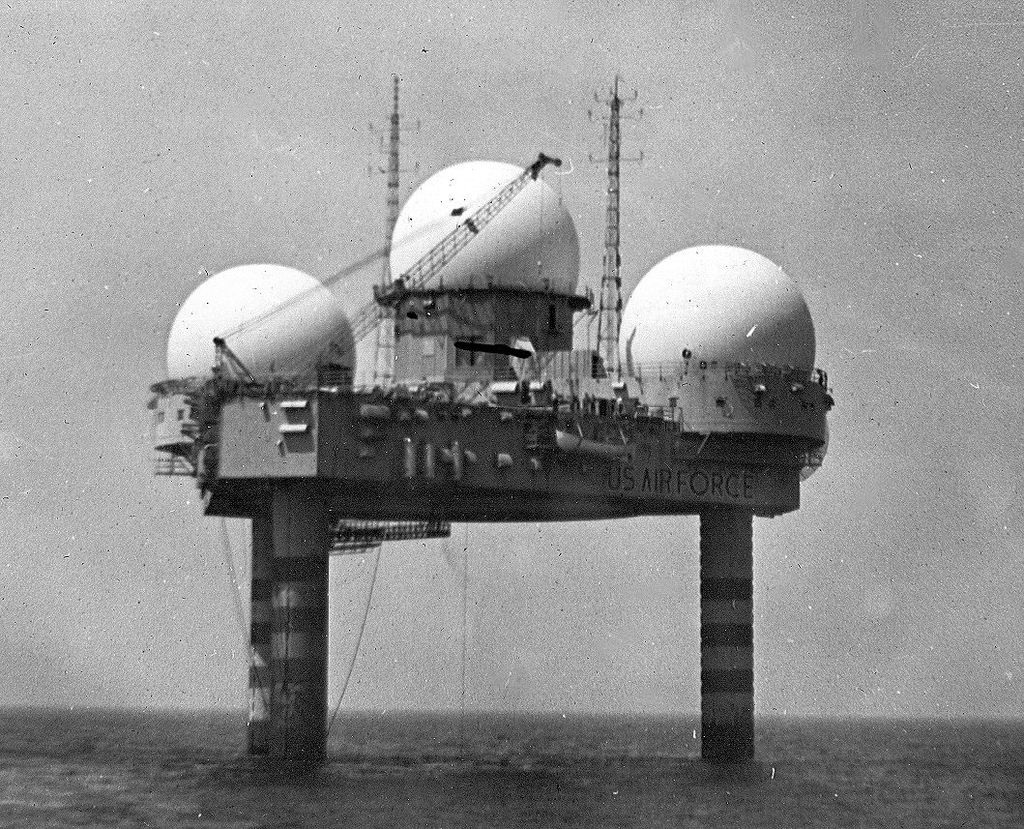In the mid 50s the USAF began construction of several long-range air surveillance radars off the east coast of the United States. Known as "Texas Towers" due to their resemblance to offshore oil rigs, the stations were positioned up to 100 miles off the coast, thus extending the range of the USAF's "distant early warning" system.
Texas Tower 4 was begun in 1956, in just just under 200' of water roughly 70 miles due east of Toms River, NJ. When it became operational in 1958 it sported an AN/FPS-3 search radar and two AN/FPS-6 height finder radars. TT4 was manned by the 646th Radar Squadron based in Highlands, NJ. Duty personnel were rotated to the offshore site by boat or helicopter.
The design specification for the Texas Towers call for them to be able to withstand 130mph winds and 60' seas - which the USAF quickly realized was marginal with respect to actual conditions in the North Atlantic off the coast of New Jersey. TT4 was severely damaged by Hurricane Donna in 1960 and, on January 15, 1961, a winter nor'easter caused the site to break up, with the loss of all 28 airmen aboard.
The wreckage from the site rises to heights of about 40' above the seabed and is well known to offshore fishermen in the region. The precise location of TT4 is marked by NOAA Buoy 44066.
Pour one out for Texas Tower #4 and the 28 personnel who lost their lives on this day, 62 years ago. Radar station personnel lived dangerous lives during the Cold War - their duty stations were almost always in the shittiest, most dangerous places on the planet and were frequently subject to enemy fire, even during peacetime.

Texas Tower 4 was begun in 1956, in just just under 200' of water roughly 70 miles due east of Toms River, NJ. When it became operational in 1958 it sported an AN/FPS-3 search radar and two AN/FPS-6 height finder radars. TT4 was manned by the 646th Radar Squadron based in Highlands, NJ. Duty personnel were rotated to the offshore site by boat or helicopter.
The design specification for the Texas Towers call for them to be able to withstand 130mph winds and 60' seas - which the USAF quickly realized was marginal with respect to actual conditions in the North Atlantic off the coast of New Jersey. TT4 was severely damaged by Hurricane Donna in 1960 and, on January 15, 1961, a winter nor'easter caused the site to break up, with the loss of all 28 airmen aboard.
The wreckage from the site rises to heights of about 40' above the seabed and is well known to offshore fishermen in the region. The precise location of TT4 is marked by NOAA Buoy 44066.
Pour one out for Texas Tower #4 and the 28 personnel who lost their lives on this day, 62 years ago. Radar station personnel lived dangerous lives during the Cold War - their duty stations were almost always in the shittiest, most dangerous places on the planet and were frequently subject to enemy fire, even during peacetime.

Last edited:

